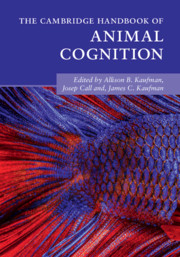Book contents
- The Cambridge Handbook of Animal Cognition
- The Cambridge Handbook of Animal Cognition
- Copyright page
- Dedication
- Contents
- Figures, Tables, and Boxes
- Contributors
- Acknowledgments
- Introduction
- Part I Communication and Language
- Part II Memory and Recall
- Part III Social Cognition
- Part IV Social Learning and Teaching
- Part V Numerical and Quantitative Abilities
- 24 Numerical and Quantitative Abilities Overview
- 25 Numerical Competence in Fish
- 26 Spatial–Numerical Association in Nonhuman Animals
- 27 Perceptual Categorization in Pigeons
- Part VI Innovation and Problem-Solving
- Index
- References
26 - Spatial–Numerical Association in Nonhuman Animals
from Part V - Numerical and Quantitative Abilities
Published online by Cambridge University Press: 01 July 2021
- The Cambridge Handbook of Animal Cognition
- The Cambridge Handbook of Animal Cognition
- Copyright page
- Dedication
- Contents
- Figures, Tables, and Boxes
- Contributors
- Acknowledgments
- Introduction
- Part I Communication and Language
- Part II Memory and Recall
- Part III Social Cognition
- Part IV Social Learning and Teaching
- Part V Numerical and Quantitative Abilities
- 24 Numerical and Quantitative Abilities Overview
- 25 Numerical Competence in Fish
- 26 Spatial–Numerical Association in Nonhuman Animals
- 27 Perceptual Categorization in Pigeons
- Part VI Innovation and Problem-Solving
- Index
- References
Summary
Non-symbolic numerical competences are widespread among preverbal infants and nonhuman animals. Moreover, signature effects that characterize numerical processing are similar between humans and other animals. This suggests a phylogenetically ancient mechanism to support non-symbolic numerical cognition (“number sense”). Here we review studies that used domestic chicks to study the ontogenetic origins of numerical knowledge. This research revealed an association between numbers and space (with smaller numbers associated with the left side of space, and bigger numbers with the right side). This is a crucial feature of non-symbolic numerical cognition, shared between humans and other animals.In the initial part of the chapter, we focus on evidence of chick’s ordinal numerical competence. When tested for their ordinal competence, chicks are predisposed to “count from left to right,” much like most humans. This bias depends on availability of spatial information to solve the ordinal task. When this was prevented, chicks were still able to perform the ordinal tasks, but without any lateralization of performance. Evidence obtained in chicks is discussed also in comparison with primates. This allows addressing whether the degree of visual lateralization and functional segregation between the hemispheres might affect number–space associations in nonhuman animals. In the second part of the chapter, we review evidence from tasks that involve the processing of quantity or number information. Again, domestic chicks showed signs of a number–space association. Even in the absence of any specific numerical training, chicks showed a spontaneous association of bigger numerousness with the right side of space. In a subsequent, strictly controlled experiment, numerical training was used to simultaneously demonstrate a leftward bias for smaller numbers and a rightward bias for bigger numbers. We also obtained evidence that the same number or quantity can be associated with the left or the right space, depending on the reference point to which it is compared. Overall, this tendency to map ordinal information with a left-to-right orientation indicates that number–space associations are not a perquisite of the human species and can occur in the absence of language or formal enculturation.
Keywords
- Type
- Chapter
- Information
- The Cambridge Handbook of Animal Cognition , pp. 602 - 620Publisher: Cambridge University PressPrint publication year: 2021
References
- 3
- Cited by



